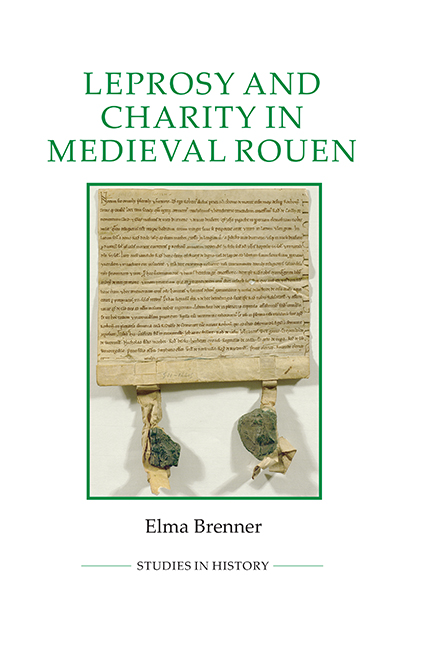Book contents
- Frontmatter
- Dedication
- Contents
- List of Illustrations
- Acknowledgements
- Abbreviations
- Introduction: Leprosy, Charity and Rouen
- 1 Rouen’s Principal Leper House: Mont-aux-Malades and Its Endowment
- 2 Charity and Community at Mont-aux-Malades
- 3 Rouen’s Other Leper Houses: Institutions, Gender and Status
- 4 Leprosy and the Medical World of Rouen
- 5 Leprosy and the Religious Culture of Rouen
- Conclusion
- Appendix 1 A Note on Sources
- Appendix 2 Charters and other Documents Relating to Leprosy in Rouen, c. 1100–c. 1500
- Bibliography
- Index
5 - Leprosy and the Religious Culture of Rouen
Published online by Cambridge University Press: 07 May 2022
- Frontmatter
- Dedication
- Contents
- List of Illustrations
- Acknowledgements
- Abbreviations
- Introduction: Leprosy, Charity and Rouen
- 1 Rouen’s Principal Leper House: Mont-aux-Malades and Its Endowment
- 2 Charity and Community at Mont-aux-Malades
- 3 Rouen’s Other Leper Houses: Institutions, Gender and Status
- 4 Leprosy and the Medical World of Rouen
- 5 Leprosy and the Religious Culture of Rouen
- Conclusion
- Appendix 1 A Note on Sources
- Appendix 2 Charters and other Documents Relating to Leprosy in Rouen, c. 1100–c. 1500
- Bibliography
- Index
Summary
Religious worship was a central aspect of life in the medieval leper house. Pious activities were intended to ensure the spiritual wellbeing of the leprous and non-leprous members of the resident community, as well as its benefactors. The extant architectural remains of the churches of Saint-Jacques and Saint-Thomas at Mont-aux-Malades, and the chapel of Saint-Julien at Salleaux- Puelles, facilitate an understanding of the multiple spiritual functions of these institutions. Within these churches, masses were said, candles were lit on behalf of benefactors and many other observances took place. The churches also housed liturgical objects and relics, and they, and the cemeteries associated with them, were sites of burial. The popularity of Mont-aux- Malades as a site of lay piety was in large part due to the flourishing cult of St Thomas Becket from the late twelfth century. Yet the presence of lepers was also important: donations to Mont-aux-Malades and Salle-aux-Puelles were motivated by the perception that lepers’ prayers were particularly efficacious, and the view that this group should be supported in pursuing a religious vocation. Liturgical practice and piety at these two institutions reflect their monastic organisation, as well as the understanding that the care of the body was inseparable from that of the soul.
Liturgical spaces at Mont-aux-Malades and Salle-aux-Puelles
Rouen's two major leper houses were equipped with fine churches, reflecting their high status as institutions, and the importance of liturgy within the daily routine of their communities. At Mont-aux-Malades, the first priory church, dedicated to St James, was built in the first part of the twelfth century, probably by about 1140, by which time Augustinian canons had probably been installed at the leprosarium. The church was constructed near the Roman road between Rouen and Lillebonne (now rue Louis Pasteur). Although only four bays of the nave remain standing today, this was undoubtedly a large and impressive church: the extant part of the nave measures 18.5 by 6.5 metres (see Figure 5). The nave was flanked by side-aisles; these, and the semi-circular choir and the apse, have now disappeared. There was also a bell tower, meaning that the church's silhouette would have stood out prominently to those travelling along the road.
- Type
- Chapter
- Information
- Leprosy and Charity in Medieval Rouen , pp. 109 - 131Publisher: Boydell & BrewerPrint publication year: 2015

